In this episode of the eLife podcast we hear about the first heartbeat, African sleeping sickness, elephant genetics, the rubber hand illusion and women in science.
In this episode
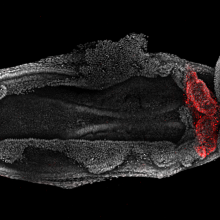
00:33 - The first heartbeat
The first heartbeat
with Paul Riley, University of Oxford
The heart is one of the first organs to form during mammalian development and, in a human, was though to form a beating structure from 3 weeks following conception. 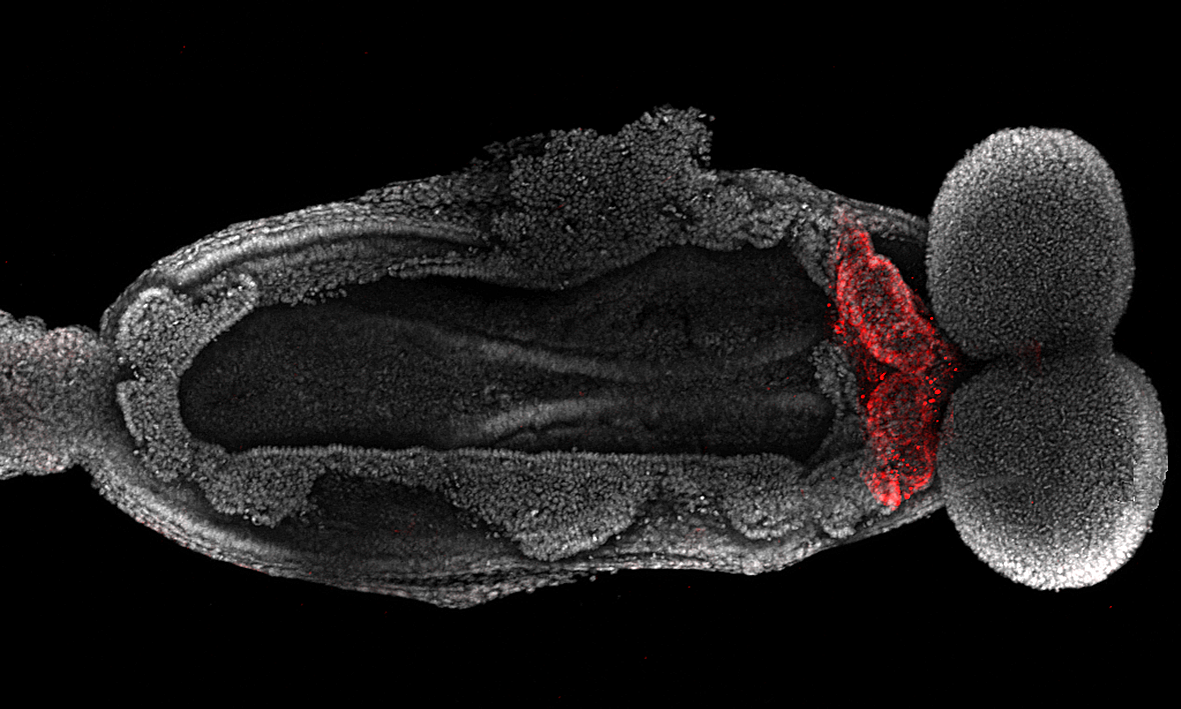 But now new imaging techniques have shown that the process occurs even earlier. By just 16 days there are already cells destined to form the future heart. These cells show surges of calcium that will later translate into heartbeats. The discovery is important because, with 1 in every 180 babies affected, congenital heart disease is one of the most common developmental disorders; it may also inform how we progress the use of stem cells to repair damaged adult hearts too. From the University of Oxford, Paul Riley explained the findings to Chris Smith...
But now new imaging techniques have shown that the process occurs even earlier. By just 16 days there are already cells destined to form the future heart. These cells show surges of calcium that will later translate into heartbeats. The discovery is important because, with 1 in every 180 babies affected, congenital heart disease is one of the most common developmental disorders; it may also inform how we progress the use of stem cells to repair damaged adult hearts too. From the University of Oxford, Paul Riley explained the findings to Chris Smith...
Paul - Basically, we found that the heart beats earlier than was previously thought. So, it starts to beat with very early forming heart muscle cells as the heart forms a crescent shape. And this was before the stage that was previously thought, which was more like a linear heart tube which is in the mouse, at least a sort of day, day and a half later which equated to humans of about 5 days' time difference.
Chris - So in a human embryo, how early would we, if humans are analogous to the mice you've been studying begin to see a heartbeat.
Paul - So, if the analogy is exactly accurate then we have to take that with a slight grain of salt. The match up would be around about day 16 of human pregnancy.
Chris - Which is incredibly early, isn't it? I mean there's not very much to a human embryo at that stage of development.
Paul - That's correct and certainly, the heart, in terms of a sort of organ we would perceive is a very early forming tissue and it really hasn't got all of the structure that we would normally associate with a heart at that stage.
Chris - How does the heart form?
Paul - Well, it forms for a whole series of cellular and molecular processes. But basically, there is this specification of cells either side of the embryo's midline. They come together at the middle of the embryo, they form this linear heart tube, that heart tube loops, and this looping aligns the chambers correctly and the inflow and outflow regions of the heart. Those chambers then specify, grow, they divide to make sure the blood flow is in one direction, and then there's further growth and expansion. So that's a simplistic way of looking at how the heart forms. So, we're talking about the very early stage when the heart exists as a few cells either side of the embryo's midline.
Chris - How did you find that these heart cells are effectively beginning to beat so early in development and why was it missed before?
Paul - Well, I think the issue here is the work that Shankar Srinivas has pioneered in imaging the life early mouse embryo. And so, what we're able to do is we're able to look very, very early stages and then appreciate that these cells were actually contracting. And then we're also able to look at the key events that are required for that contraction - how do these heart cells beat and what's the requirement for that? And it turned out to be calcium signals.
Chris - Why is calcium important?
Paul - Calcium is very important because it interacts with the contractile machinery of the heart muscle cell. And that enables the contractile process, so the beating. But what we found was actually, cells were positive if you like, for calcium signal before even the contraction event occurred.
Chris - So, are you saying then that these cells already know that they're going to be cardiac cells. They're already beginning to set up these fluxes or spikes of calcium which would normally coincide with a heartbeat but that then comes along a bit later so the calcium spikes might be in some way encouraging the cells to turn into heart cells.
Paul - Absolutely correct. The idea is that we think the calcium signal is an early defining event. It happens in a sort of random process within cells and we don't understand how that occurs and which cells tend to turn on the signal before others and also, how those cells then synchronize this calcium signal. But what we think happens is that calcium then is also important for the actual process of this heart muscle cell, differentiating and maturing properly.
Chris - Given how common the congenital heart problems are as a group, I suppose understanding this process and how heart cells get specified is going to be fundamental to understanding congenital heart disease but also, potentially putting hearts right.
Paul - That's correct. We think that two-fold application of the work if you extend it into the human setting and the disease setting, and that is one, understanding the fundamental processes of birth defects in congenital heart disease, i.e. at the level of how the heart starts to contract, what happens if that goes wrong. If for example, those cells that start to beat don't synchronise properly and don't communicate with each other properly. And we also think there's an important component here as applies to adult heart repair because if we're thinking about introducing new heart muscle into a patient who's had a heart attack for example then how that heart muscle needs to start to beat and integrate and communicate with the survived heart muscle of the patient is really important.
Chris - Do you know yet what those cells are doing in order to produce these interesting calcium signals and how are they doing that?
Paul - Well, we know that one of the key events is they need to express a particular ion channel which actually exchanges the calcium for sodium. Interestingly, there's an ionic balance of these different signals. And so, the expression of this channel which is called the NCX - so the sodium calcium exchanger is really important in these specifying heart muscle cells in this early stages. And what that enables then is for calcium to enter the cell. and so, that's the key event. We don't know why as I say, particular cells in this early forming heart start to do that early than others. The progression of events and how that becomes sort of synchronized that these heart cells communicate. And these are studies which are ongoing particularly in my colleague Shankar Srinivas's lab as he looks at single cell sequencing to determine key molecular profiles of these individual cells from this forming heart.
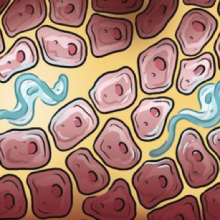
06:42 - Lurking in the skin
Lurking in the skin
with Annette MacLeod, University of Glasgow
African sleeping sickness or "trypanosomiasis" is one of a list of topical illnesses that the World Health Organisation wants to stamp out and a they've set an ambitious target to cut cases to under 1 in 10,000 of the population in 90% of the areas that are affected.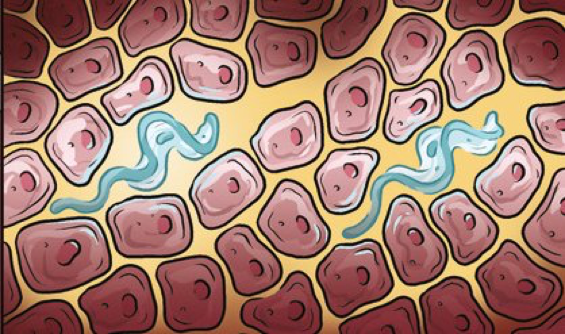
But new research from Glasgow parasitologist Annette MacLeod, suggests that there might be a tsetse fly or two in the ointment, because she's discovered a formerly unrecognised reservoir of the infection, lurking in the skin of apparently healthy people...
Annette - African trypanosomes are protozoan parasites that cause the foetal disease human African trypanosomiasis or sometimes known as African sleeping sickness. This is found in sub-Saharan Africa and it is transmitted from person to person by the bite of a tsetse fly when it takes a blood meal. A number of cases of sleeping sickness has gone down in recent years due to concerted efforts by the WHO and national control programs to try and control the disease. A number of cases has dropped below 10,000 for the first time in 50 years. But we've been here before. In the 1960s, the number of reported cases was below 10,000 and then we took our eye off the ball and the disease re-emerged and it peaked up at 300,000 in the 1990s. Now, we have the disease under control again. The important thing is not to let the disease re-emerge. But there are still these stubborn pockets of disease that just won't go away. We need to understand how the parasite has escaped the elimination before so we can stop it doing it again.
Chris - Where do you think it might be lurking?
Annette - Well, we think there are some people that have lower numbers of parasites in their blood and they have no symptoms. These people are missed by the screening process but they are infected. Evidence suggests that they are able to transmit the disease. The question is how.
Chris - I guess then so, where are the parasites lurking in those people? if they are not in the blood, where are they?
Annette - That's a crucial question and that's what we have discovered. We have discovered a hidden reservoir of these parasites hiding in the skin. These skin-dwelling parasites can be picked up when the tsetse fly takes a blood meal and so, spreads the disease.
Chris - I guess everyone had assumed that because these insects are drinking blood, that must be the crucial route through which anything gets transmitted into the fly. But if the parasites are in the skin, in the course of getting to the blood, that's when they might be picking them up.
Annette - Yes, because tsetse flies have serrations along their proboscis that actually makes a mess of the skin and the tsetse bite is quite sore. It feeds on the pool of blood and lymph that collects as it bites.
Chris - People talk about this being slash and suck, don't they?
Annette - Yes, that's right. It's a slash and suck kind of insect.
Chris - And so, if these trypanosomes are sitting there in the skin as this serrated mouth part goes through then it could draw in the parasites via that route.
Annette - That's right.
Chris - How do you know this is happening? How did you find this?
Annette - Well, what we did, we had fairly simple experiments where we label the parasites and then we used different live in-vivo imaging technologies to observe where the parasites go.
Chris - When you said "label", how?
Annette - We have them expressing of fluorescent tag so that they glow red or green. What we found is that we could follow these parasites in a live animal over time.
Chris - Do you think this is relevant to what's happening in these people because obviously, you're not doing this in people, you're doing this in experimental animals so, do you think that's a good representation of the human equivalent?
Annette - Yes. First of all, we looked in mice. We found that the parasites were in the skin of mice. We found that these skin-dwelling parasites in mice could be transmitted to tsetse flies when we fed tsetse flies on the mice. And some mice have very low parasitemia. So that means they had very low numbers of parasites in their blood. But they did have skin-dwelling parasites. And these skin-dwelling parasites were able to infect the tsetse flies. Obviously, you can't do these experiments in humans but we managed to obtain skin biopsies for over a thousand people living in an endemic focus in the Democratic Republic of Congo. We looked in these biopsies for the parasites. We found people that had parasites in their skin. And these people had not been diagnosed before. They had not been diagnosed as having sleeping sickness. They didn't have clinical signs and they didn't seem to have any parasites in their blood.
Chris - But crucially, does the bug respond to the same treatment one would meet out to somebody who has parasites in their blood or in the skin? In other words, if we can find it, we can just get rid of it.
Annette - That's something that hasn't been tested before. We've not tested the current drugs to see if they can eliminate the skin-dwelling parasites. But that is a crucial step that we must do. And if any new drugs come along, we must make sure that they are able to kill these skin-dwelling parasites, as well as the blood parasites. So current policy is not to treat people with asymptomatic infections, but we think that it needs to be reconsidered in the light of these individuals that can persist and transmit the disease.
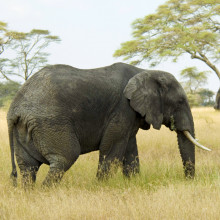
12:49 - Why don't elephants get cancer?
Why don't elephants get cancer?
with Vinny Lynch, University of Chicago
It follows that, the bigger you are, the more cells you have and therefore the higher the likelihood of one of those cells becoming cancerous.
But if you look at progressively larger animals you don't see an increased rate of cancer. This is called Peto's Paradox after Oxford University's Richard Peto who pointed out - on a cell-by-cell basis, humans have a lower cancer risk than a mouse. So why does it happen?
The University of Chicago's Vinny Lynch has been looking at elephants for inspiration...
Vinny - So we were curious in why elephants don't get cancer and we cared about elephants because their closest living relatives is actually very, very small. It's about the size of a groundhog or a small cat or something that's called a hyrax. So, within a few million years after these things diverged, elephants ancestrally went from being very small to being huge. So because these two things are closely related to each other, we can therefore compare their genomes to see what genetic case occurred in elephants that may be associated with an increased ability to kill cancer cells or maybe to stop cells from becoming cancerous to begin with. So we basically just looked in the elephant genomes for things that might be associated with cancerous events.
Chris - Did you just go to the database and get the DNA sequences of different elephants or did you get some real elephant DNA for yourself?
Vinny - So we have real elephant DNA and we have elephant cells but it was even easier. So for 10 years or more now, the NIH and lots of other foundations around the world have been sequencing animal genomes. So the elephant genome and the hyrax genome along with many others had already been sequenced. So we were basically able to just go to this website and type in a bunch of names of the genes that we're interested in and see them pop up on the screen. So we did that for a couple of elephant genes and found some things that we thought might be associated with enhanced resistance to cancer in elephants.
Chris - Did you literally do a letter by letter comparison or were you saying, "Well, we know that there are certain mechanisms that cells use to stop cancers in their tracks. There are certain genes that cause cancer so we're going to focus our attention on both of those and see if there's a difference."
Vinny - That's exactly what we did. So cancer has been very well studied for decades now so we know that they're basically - at least in cancer biology, there's two different kinds of genes. There are genes called the oncogenes and when they're mutated, they cause cancer and there are genes that are called tumour suppressors and their job is to supress the formation of tumours. They did very well characterize about a few hundred of each kind so we just wanted them to be elephant genome and counted up how many tumour suppressors they had and how many oncogenes they had. We found that for this one special kind of tumour suppressor, they had 20 copies whereas every other animal that we looked at had one.
Chris - Are those copies all functional because one of the things that we have learned from the human genome project is that there are sort of fossilised copies of certain genes lurking in the genome. When you read for them, you can find these genes there. It doesn't mean they work though. So do these 20 copies in the elephants actually do something?
Vinny - So it looks like about half of them. So maybe 10 have signatures that they do something and then the remainder have signatures of these non-functional genes. They're called pseudo-genes because they look like genes, but they're not really genes. So I think a subset of them are actually functional.
Chris - The oncogenes: did you see any evidence that they have fewer abilities for cells to become cancerous in the first place?
Vinny - So, we didn't find that elephants had fewer oncogenes. So that couldn't be the strategy. If you have these genes, when they get mutated, they cause cancer. One way you can reduce your risk of developing cancer is to just get rid of these genes. But elephants had just as many as everybody else. That's not entirely unusual, because these oncogenes play essential roles in animal development. So it's probably the case that, if you got rid of them, your development would be weird. So, they're probably really conserved. You can't mess with them.
Chris - So it does look like the mechanism, at least in elephants, is a big expansion of your ability to supress cancer in cells; but what about other animals? Because elephants, just because you see it in them, it doesn't prove the rule, does it? What about other close relatives of elephants, things like mammoths, or other massive animals like whales? Have you looked in those examples for instance?
Vinny - So we've looked in mammoths. Mammoths are most closely related to Asian elephants. Both mammoths and Asian elephants, for which there's also a genome data have similar numbers to African elephants. So, there seems to be this increase in the copy number of the special gene called the p53, seems to be an elephant thing. but then we did obviously figure if it's expanded in elephants, what's going on with these other things that don't seem to get cancer at the rate that they should. At least for whales, we didn't find a change in the number of this gene in whales so whales have one copy just like everybody else. We did however see that there's one lineage of bats which are very small but live a very, very long time, they may have extra copies. We haven't checked it down entirely yet. We're working on that now, but it looks like at least initially that they have one extra copy.
Chris - And rhinos, hippos, they're also pretty big. Do they also show an expansion of these p53 genes?
Vinny - So, we've looked at everything that we could find including rhinos and hippos, and they don't seem to have an expansion of these p53 genes which is probably telling us something more fundamental about evolution and that, there's more than one way to solve a problem. So elephants found this particular way to solve the problem but the other lineages that get big or live a long time like bats live a long time, whales live a long time, and rhinos, and hippos. They just found other ways to do it.
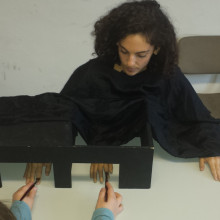
18:34 - Out of control: the rubber hand illusion
Out of control: the rubber hand illusion
with Francesca Gabarini, University of Turin
If you're brave enough, you could try this: lay one hand on a tabletop and put the other out of sight below. Place a rubber hand on the table where your hidden hand would naturally rest next to its neighbour. 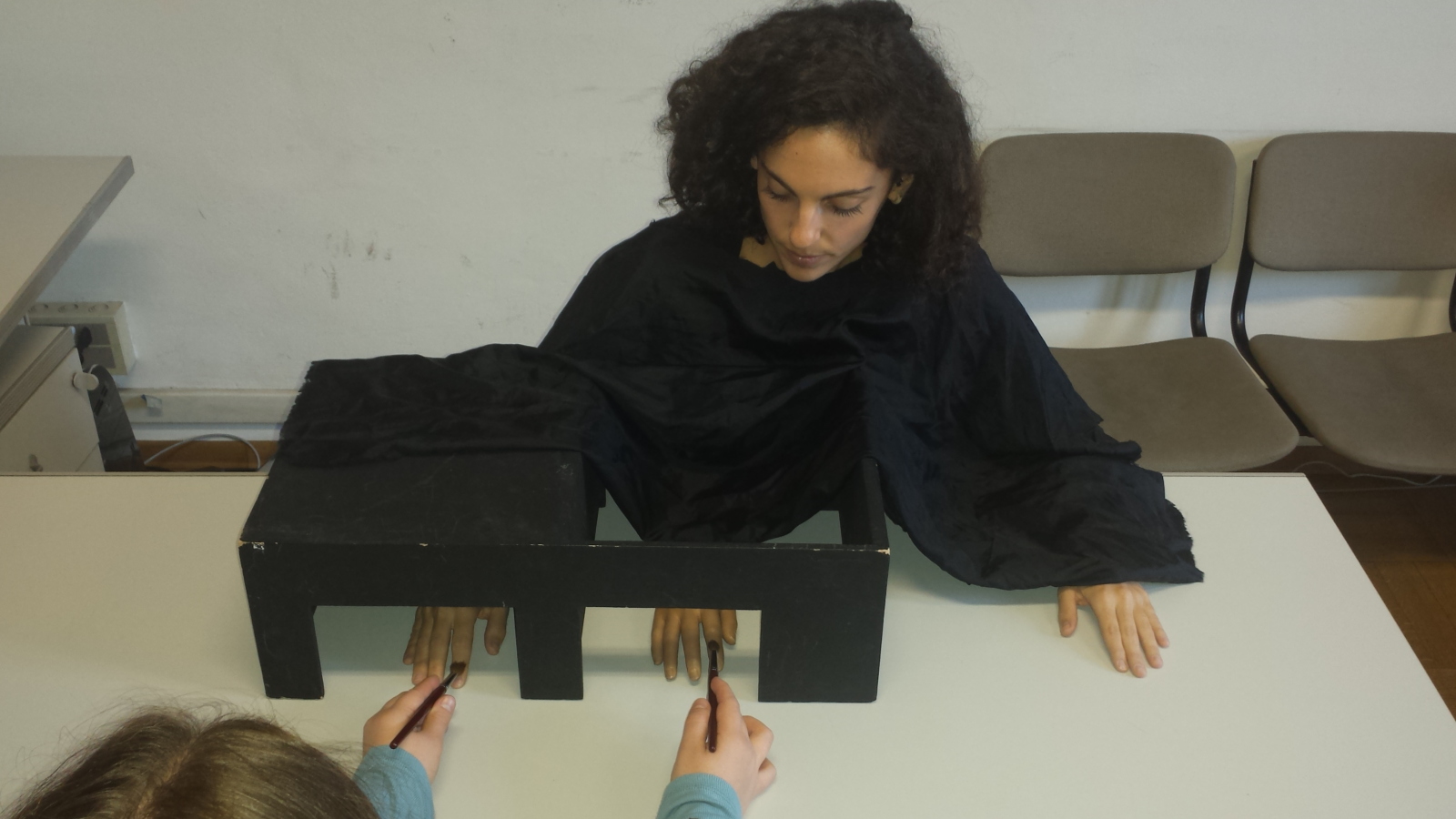 And have someone stroke the index finger of your real hidden hand, and the index finger of the rubber hand at the same time. It's hard to resist forming the distinct impression that the rubber hand in front of you is not your own real hand. And if someone hits it with a hammer you feel momentarily terrified that it's going to be agonisingly painful.
And have someone stroke the index finger of your real hidden hand, and the index finger of the rubber hand at the same time. It's hard to resist forming the distinct impression that the rubber hand in front of you is not your own real hand. And if someone hits it with a hammer you feel momentarily terrified that it's going to be agonisingly painful.
Why this rubber hand illusion works, we don't know; but Francesca Gabarini has found that when the illusion takes place, the motor circuits controlling movements in your real hand become powerfully depressed, as though they've been deprioritised as your attention transfers itself to the fake hand and you assimilate it into your body image...
Francesca - The sense of body ownership is the feeling that specific body parts belong to ourselves that we usually take for granted. But it can be selectively altered after brain damage when patient lose the capacity to discriminate between the own and the other body parts or there's a body ownership can be also altered during a famous experimental procedure that is the rubber hand illusion.
Chris - Okay, so tell us first of all, for those not in the know, what is the rubber hand illusion and how do you do that?
Francesca - Watching a rubber hand being touched while one's own hand hidden of the view if touched synchronously leads to a sense of body ownership over the rubber hand. And also, this leads to a shift in the perceived position of the real hand towards the rubber hand. This generates a sort of disembodiment in the real hand of the subject.
Chris - So in the mind of the person who is seeing a rubber hand on the table in front of them, their own hand might be say, hidden under the table and you stroke the rubber hand in the same place as you stroke the real hand, you end up with the person believing that the rubber hand is their own hand and one would believe that their body image, the brain accommodates their body image to include the rubber hand rather than their own real hand.
Francesca - Yes. We are able to manipulate the sense of body ownership in every participant but it's important to keep in mind that healthy subjects are always aware that it is an illusionary procedure. So they are not inducing thinking that the rubber hand is actually their own hand.
Chris - Once you've got the people experiencing the rubber hand illusion, what measurements do you make? What do you do to them next?
Francesca - We are interested in recording some motor parameters because we are interested in investigated how the human motors system reacts when a subject's sense of body ownership is altered during the rubber hand illusion. So, during the experiment, the region of the brain that controls movement and in particular hand movements was artificially stimulated by using a specific technique that is transcranial magnetic stimulation, TMS to stimulate the part of the brain involved in controlling movement that is the motor cortex. So, the magnetic stimulation generates electrical signals that travel down to the spinal cord and to the muscles, generating muscle contractions that can be measured and that we called motor evoked potential. We measured the size of these motor evoked potential and the motor evoked potential reflect the ability of the motor cortex to create, to produce the movement of the hand.
Chris - What do you find then when you compare the level of preparedness of the motor circuits when a person is or isn't experiencing the rubber hand illusion? Is there a difference?
Francesca - Yes. When subjects experienced the rubber hand illusion, we found a strong and very dramatic decrease of the amplitude of the motor evoked potential. This means that motor cortex is less able to induce the movement and the deluded hand is less ready to move. So, this means that the motor system during the illusion is down regulated.
Chris - Why would that happen because the person still believes they have a hand and they still potentially may want to move that hand, so why should believing that a rubber hand on the desk, why should that be reflected in a change in the degree of facilitation or preparedness of their motor areas?
Francesca - Because if the brain no longer considered the hand as a part of the own body, it is not able to exert a control over a body part that is no longer a part of the body. So, what we can see is that the sense of body ownership strictly depends on the possibility of movement because basically, if I believe that the hand is mine, I must be ready to use it.
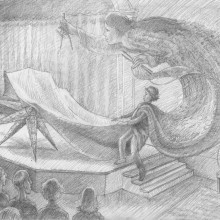
24:32 - A woman in science: Indira Raman
A woman in science: Indira Raman
with Indira Raman, Northwestern University
Now in each episode, alongside the research, we also try to delve in other aspects of practising science; previously we've looked at funding, or rather the lack of it, and we've also recently explored public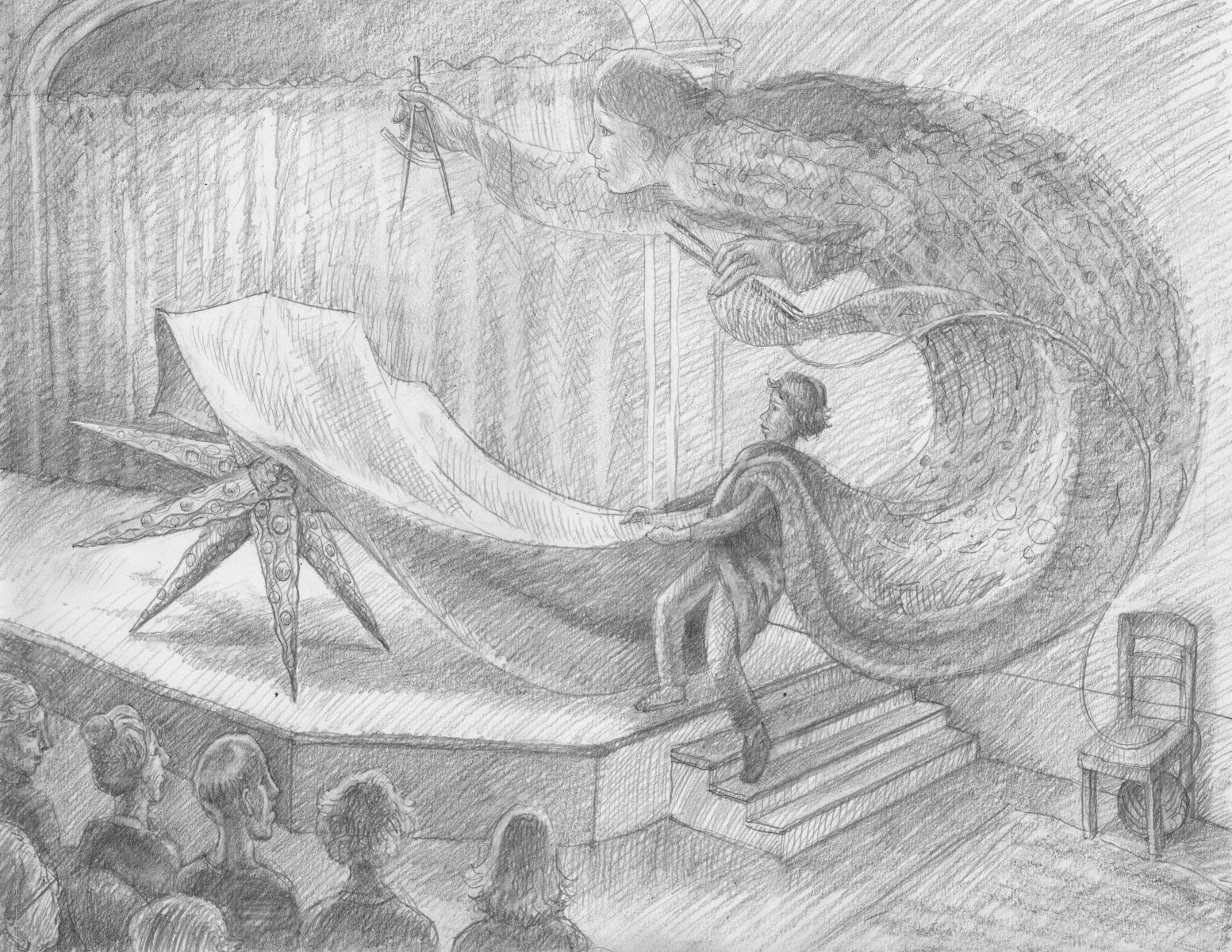 engagement and developing the problem solving skills of undergraduates.
engagement and developing the problem solving skills of undergraduates.
This month, Chris Smith hears a personal insight into a perennial problem...
Indira - My name is Indira Raman. I'm in the department of neurobiology at Northwestern University.
Chris - What really struck me about your perspective in eLife this month Indira, is that you opened by saying, "In my 18 years as a professor of neurobiology, I've been asked to speak as scientist because I'm a woman. But this is the first time I've been asked to speak as a woman because I'm a scientist." Elaborate.
Indira - Well, as one knows, very often in many scientific venues, there's a growing interest in ensuring that a group of people that is speaking represents a diverse cross-section of the scientific population. And so, I've been asked to speak as a scientist because of my science but very often, I'm also aware that the organisers are interested in having a representation of women and I am a woman. But in this case, the focus was different and I was asked to speak about my experiences as a scientist because of being female. I chose to do it in a way that seemed to be compatible to me with my experience of talking about science.
Chris - How does this whole kind of, "I get asked to talk about science because I'm a woman" - how does that go down with you? It's good to be gender neutral but what I think would really upset someone is if they heard that and then thought they had been elected to appear on a programme because of their sex, not because they're good at science.
Indira - Right. I think that this is a central question of our time because on the one hand, we want to encourage diversity and I think that that's a laudable goal that I support. But we also want to maintain, as you're saying, the highest calibre of participants. I think those things sometimes work together and sometimes and sometimes move into conflict, and that's why I called it out at the beginning. That's why I mentioned in the piece, the way that I deal with that is internal with this idea that I walk on stage as a woman and walk off stage as a scientist.
Chris - In your view, why are we in the position we're in where we actually see that the bottom end of the scientific tree coming in, the input pipe if you like, has a very healthy proportion of women? But when you look at what comes out at the other end and turns into people of your sort of calibre, they've all vanished. You're a very rare species, why?
Indira - I don't think there's a simple answer to that question. There are many reasons why people stay in science. There are many reasons why people may leave it. There's one very straightforward element of being female that can be complicated to tie in with a scientific career and that's childbearing. There's a tremendous element of uncertainty and a lack of security through ones 20s and often ones 30s. Some people respond to what they see as a social dynamic within science. It can be very competitive. There is the intensity of the work where one really almost never goes home and leaves it completely behind them. As it turns out, there are proportionately more women who decide, "This career is not for me"
Chris - But the majority of the reasons you have highlighted apply to men too. But they don't leave in the same proportions or on mass the same way the women do, do they?
Indira - Correct. So for whatever set of reasons, there are more women who decide that those attributes of the field are elements that they don't really want to maintain in their daily lives.
Chris - People often talk about their being role models and the way to solve a lot of this is to have good role models. This will attract more people of a particular persuasion, gender background, whatever into a particular area. Do you go along with that or do you think actually that you can have as many role models as you like if the system is broken, as soon as you take the pressure off, it will just relapse back to the broken type it was to start with.
Indira - I think that it's important to think about role models in a broad sense and think what is it actually that you are wanting to model yourself after. My own experience was that I worked for 4 men as I was being trained. They were all white American men and they were tremendous role models for me because what they modelled for me was a way to do science, a way to be just in one's thinking and careful in one's thinking, and humane in one's behaviour. And those were the things that I wanted to have modelled. I should say that I am half Indian from India and half Caribbean. There was nobody like me. It was very unlikely I was going to find a half Caribbean, half Indian female role model who was doing electrophysiology for me to model myself after. And so, I found other ways of recognising pieces of myself in people who didn't happen to share many of my attributes. I have found it possible to be a role model for students from all over the world - male and female. A big discovery for me when I was an undergraduate was finding out that there were other people at my college from many different countries who actually shared many of the experiences that I had. And so, I think that as we learn to expand our notion of role models, we will be able to reach across the divides because otherwise, we'll never change the proportions of people in science because we'll be operating on the assumption that one can only train someone who is like you.
- Previous What's between my internal organs?
- Next How to be an astronaut









Comments
Add a comment